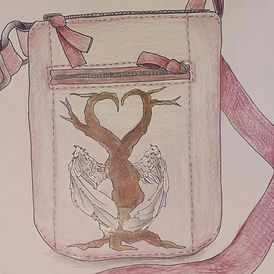Art 211
211 Studio Assignment
1A: understands the elements of design: color, form, line, shape, space, texture, and value.
1B: understands the principles of design: balance, contrast, harmony, movement, pattern,
repetition, rhythm, and unity.
1C: understands the expressive qualities and communication of ideas.
Description: this is my demo and the unit plan for an assignment I created for my students that I taught for two weeks. The goal of the assignment was to explore identity through the use of symbols to create an original icon and then use that icon to create a product design that enhances the meaning of the icon. I used colored pencils on bristol paper to create my designs.
Rationale: this work shows my ability to communicate my identity through a combination of expressive symbols carefully placed using value, color, and form to create a unified composition that works as a product design.
Studio Assingment Self Assessment
3A: understands media and tools and how to use them in a safe and responsible manner.
1G: analyzes and evaluates (critiques) artworks for how aesthetic qualities are used to convey intent, expressive ideas, and/or meaning.
Description: This is my artist statement that I wrote for the studio assignment above. It touches on my artistic choices, my time management, as well as the artists that influenced me and critiques the level of success/how happy I was with my design.
Analysis: This statement shows that I am able to explain my artistic choices when creating a piece and then go back and analyze my choices and the final product.
Rationale: artist statement


Artist Handout
2A: understands how to compare and contrast elements, principles, and tools in two or more visual artworks.
2B: understands how to compare and contrast artworks in two or more fine arts that share processes.
2E: expressive ideas, similar themes, historical periods, or societal contexts.
5G: analyzes and evaluates similar and distinctive characteristics in and among the arts. Analyzes the function of the visual arts in various eras and cultures.
5A: understands how the visual arts function in a cultural and societal context.
1G: analyzes and evaluates (critiques) artworks for how aesthetic qualities are used to convey intent, expressive ideas, and/or meaning.
Description: This handout introduces the artist Tinker Hatfield using Conceptual Frameworks and the Frames. This handout includes background about the artist, information about their work and their practice, images of their most relevant work, questions, vocab, and art making activities.
Rationale: The handout interrogates the structural frame by asking the following questions: What role does form play in Tinker’s designs? Does the aesthetic add to the function of the shoes or is it arbitrary…why/why not? How do the principals and elements aid Tinker in his story telling?
It interrogates the Cultural Frame by asking these questions: How does a brand like Nike function in the world? Why do we buy these products? When we make art for people to purchase what does that say? What other images or products can you think of that are based off a specific person? What does that mean to purchase someone’s “signature”?
And the Postmodern Frame: What commentary or stories is Tinker telling about the athletes he designs for? What ideas is Tinker challenging about conventional shoe making/why is that important to his practice? What has he changed for the athletic shoe industry?
Evidence: Unit Plan Artist Handout
BERGER "WAYS OF SEEING" REFLECTION PAPER
5F: analyzes how the visual arts do and have been used to inform and persuade.
Description: Berger compares/contrasts the use of visual language in publicity and oil painting to make the case that publicity is highly influenced by the ideas behind and the images portrayed in oil painting.
Rationale: I used an advertisement I found from Popchips and compared it to the painting Anchors A-Wow by Gil Elvgren to support Berger's ideas that publicity pulls from the conventions of painting through the use of visual language to persuade people to buy their product.
Evidence: Ways of Seeing Analysis
